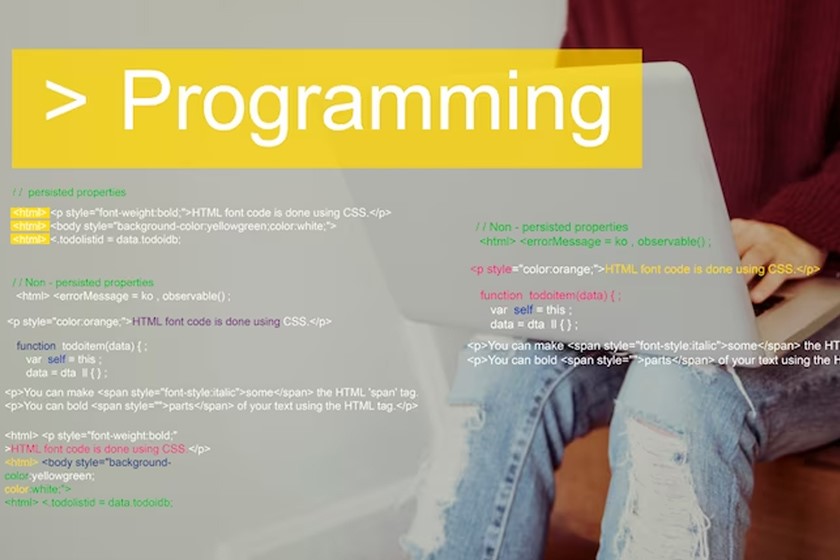Explore the programming section of a job posting site, and you’ll notice that many companies are actively seeking developers under the job title ‘Full-Stack Developer.’ You’ve likely come across numerous individuals with this job title on LinkedIn, and if you work closely with programmers, you’ve probably heard this term frequently. Now, it’s time to gain a clear understanding of what a full-stack developer truly is. If we were to describe a full-stack developer in a single word, it would be ‘all-rounder.’ Continue reading to delve deeper into the world of full-stack development.
What is full-stack?
Most applications consist of three main parts or layers: the front-end, where the user interacts; the back-end, the core of any application; and the database, which contains all the information required by the application.
The front-end, also known as the client-side, encompasses content, the appearance and layout of that content, and interactive elements. It includes all the visible elements that users see on their screens and can interact with.
The back-end, also referred to as the server-side, consists of a server that runs code to receive, handle, and process requests, along with a database for securely storing user data. All back-end processes occur behind the scenes and remain invisible to the user.
Full-stack development is a comprehensive approach that incorporates various technologies. It involves a combination of software, tools, programming languages, databases, frameworks, and data storage technologies for building and running web applications.
There is an abundance of full-stack technologies, with many employing the same programming language. One of the most popular sets is MERN, which stands for MongoDB, Express, React, and Node.js. MongoDB serves as the database, Express as the web application framework and back-end for Node.js, React as the front-end JavaScript library, and Node.js as the back-end JavaScript runtime.
A full-stack developer possesses the skills to code an application from start to finish, encompassing both front-end and back-end programming and the infrastructure on which the code runs. They have a comprehensive understanding of each component.
What does a full-stack developer do?
Stack Overflow’s latest statistics reveal that a Full Stack Developer is among the most sought-after roles in software development. However, what are the responsibilities of a full-stack developer, and what do they typically entail?
The role of a full-stack developer can vary depending on the specific task at hand. They possess the versatility to work on both the front-end and back-end aspects of development, making them valuable contributors to various projects. Consequently, they must be able to quickly and efficiently adapt to new frameworks and tools.
It is a common misconception that a full-stack developer possesses comprehensive knowledge of all aspects of web-based application development. While they have a solid understanding of the general principles and scenarios, they may not be experts in every field facet.
However, this extensive knowledge is not always necessary and doesn’t hinder their effectiveness. Their proficiency in both Front-End and Back-End development allows them to find solutions to various stages of the development process rapidly. Nonetheless, the ability to navigate seamlessly between Front-End and Back-End aspects is becoming increasingly crucial as Agile methodologies integrate with modern development approaches.
Some of the key responsibilities of a full-stack developer encompass:
- Assisting in software design and development
- Testing and debugging software to optimize it
- Writing clean code for both the front-end and back-end components of the software
- Designing user interactions within the web application itself
- Establishing a server and database for the software’s back-end
- Ensure cross-platform compatibility and optimization
- Testing and maintaining responsive design in the application
- Collaborate with graphic designers to design upcoming features
- Developing APIs and implementing RESTful services
- Staying current with technological advancements to enhance software performance
- Communicating the effectiveness of emerging technologies to decision-makers
- Attending to software security, updates, scalability, and other aspects
Full-stack developer skills

Full-stack developers often have varied job descriptions, primarily because various organizations have different requirements, necessitating a diverse skill set for this role. Below are some common abilities and skills expected of full-stack developers:
- Proficiency in HTML/CSS
- Mastery of JavaScript
- Familiarity with JavaScript frameworks such as Angular and React
- Experience in UI and API design
- Competence in working with both SQL and NoSQL databases
- Expertise in database management
- Proficiency in at least one back-end programming language, such as Python, Java, or Ruby
- Familiarity with Back-End frameworks like Django, ASP.NET, Laravel, and others
- Capable of creating and deploying automation or management systems
- Knowledge of virtualization or Docker
These skills are unique and acquired through learning and experience, forming the foundation for becoming a proficient full-stack developer. In addition to technical expertise, full-stack developers also require soft skills for effective communication, project management, and budget handling. Familiarity with Agile and Scrum methodologies can be beneficial and practical, given that software development is often collaborative. Moreover, cooperation and teamwork are essential personality traits in this field. Finally, having business acumen can be advantageous, enabling full-stack developers to understand a company’s operations and effectively solve business-related problems.”
Full-stack programming languages
Full-stack programmers must learn several programming languages. These languages are divided into Back-End and Front-End categories.
- Front-End languages, including HTML, CSS, JavaScript, and others, are utilized to create user interfaces.
- Back-End languages, such as Ruby, Python, PHP, Java, Go, Swift, and more, form the foundation for server-side operations.
While these languages can build robust websites and applications, programmers often rely on pre-made libraries to streamline their work. Examples of Front-End libraries comprise jQuery, React, and Angular, while Back-End libraries encompass Ruby on Rails, Django, and Laravel. Many of these libraries are comprehensive and specialized, demanding significant time and effort to acquire the necessary skills for effective utilization.
In addition to the programming languages mentioned above, a full-stack developer must possess substantial knowledge of SQL databases and HTTP communication protocols.
Despite proficiency in multiple programming languages, full-stack developers often collaborate with specialized Back-End and Front-End developers who understand their respective domains more deeply.
In recent years, proficiency in JavaScript, typically associated with Front-End development, has become increasingly valuable for full-stack programmers. This shift has enhanced their credibility and improved the efficiency of their programs, allowing them to invest less time and effort in mastering various programming languages.
Full stack developer salary

There are different statistics for the full-stack developer salary, and these statistics and figures are based on factors such as:
- Full-stack developer skill level
- The country where you work
- The company you work for
According to SalaryExpert, the average web application developer’s salary is as follows:
- The average web developer salary in the USA is $91,625 (USD)/yr
- The average web developer salary in the UK is £52,155 (GBP)/yr
- The average web developer salary in India is ₹11,71,75 (INR)/yr
- The average website developer salary in France is 62,889 € (EUR)/yr
- The average web developer salary in Germany is 72.407 € (EUR)/yr
- The average web developer salary in China is ¥263,887 (CNY)/yr
- The average web developer salary in Japan is ¥8,402,360 (JPY)/yr
- The average pay for a web developer in Russia is 1 056 148 ₽ (RUB)/yr
- The average web developer salary in Australia is $119,084 (AUD)/yr
- The average pay for a web developer in Canada is $101,712 (CAD)/yr
- The average pay for a web developer in Spain is 47.324 € (EUR)/yr
- The average web developer salary in Portugal is 37087 € (EUR)/yr
Full-time employees, on average, earn lower salaries but qualify for valuable benefits. But after all this information, it’s time to learn how to become a full-stack developer.
How to become a full-stack developer
There are several paths to becoming a full-stack developer. The traditional route involves attending college and studying programming. While a bachelor’s degree in computer science isn’t mandatory to start a career as a full-stack developer, it can significantly enhance your resume. Alternatively, you can embark on a self-taught journey, though some concepts may be best learned through full-stack developer courses and professional training. To help you decide among these career paths, here are the most common steps to becoming a full-stack developer:
1. Learn the basics
As a full-stack developer, having a foundational understanding of various programming languages and development and design principles is crucial. You don’t need to master everything, but you should grasp both the front-end and back-end aspects of websites or applications. Here are the key essentials to learn:
- Programming languages: This includes HTML/CSS, JavaScript, Python, PHP, SQL, and Git.
- Databases and web storage: Every website or application relies on a database to manage and store data. It is essential to understand how databases function and connect them to your chosen programming language.
- Web Applications and Servers: Web applications like the Hypertext Transfer Protocol (HTTP) facilitate communication between web clients and servers. Representational State Transfer (REST) defines standards and constraints for creating web services. Comprehending the interaction between HTTP and REST is crucial for securing a programming role.
- Web architecture: Full-stack developers must be adept at organizing data, segregating files, and determining where computational tasks should occur.

2. Focus on expertise
Becoming an expert in a specific area can be easy and rewarding once you learn web design and development basics. A full-stack developer’s expertise helps companies determine whether you are a good fit. Improve your skills and knowledge in a specific area. For example, you might work as a full-stack developer specializing in a particular area, such as web, mobile, or native application programming.
3. Improve your skills
After mastering the fundamentals, it’s important to refine further and enhance your skills. Gain practical experience by designing and coding simple websites, making them accessible across multiple platforms. Start the coding process and continually refine it. This will not only allow you to practice other related skills like content publishing and quality assurance but will also enable you to offer more value when discussing developer fees in the future.
4. Create a portfolio
Before applying for jobs, it’s essential to understand how employers view and evaluate your portfolio. Having a personal website or utilizing portfolio websites can help showcase your entire portfolio to potential employers. Your portfolio should encompass technical documentation, back-end coding, front-end design, and user experience and highlight your full-stack programming endeavors. If you lack professional experience, consider listing your course projects as part of your portfolio, increasing your chances of landing job interviews.
5. Find your right job
Full-stack developer positions are readily available, and you can start applying for them. If you’re interested in exploring various industries, you can engage with online web development forums to determine which sectors suit full-stack developers. Additionally, it’s advisable to research the companies you’re interested in and check if they have dedicated programs for hiring full-stack developers.”
Full-stack programming job outlook
According to a LinkedIn report, the demand for full-stack developers has been growing by 35% annually since 2015. The US Bureau of Labor Statistics also predicts a 13% growth in web developer employment between 2020 and 2030.
There is a significant demand for full-stack programmers across various industries, especially in the technology sector. However, there are additional reasons for hiring a full-stack developer:
- Companies prefer individuals who can oversee the entire web development process rather than hiring separate front-end and back-end developers, each focusing on specific parts of the process.
- In recent years, e-commerce and emerging technologies such as AI, IoT, blockchain, and more have amplified the demand for web developers, particularly full-stack developers. As these technologies become more widely adopted, the need for full-stack developers will continue to grow.

Final thoughts
Web design and programming skills are essential for full-stack developers. Additionally, they are responsible for team management, implementation, and supervision. Full-stack developers understand the importance of continuous learning and the need to stay updated with evolving technologies and techniques. They follow a structured plan to achieve their goals efficiently.
Be one step ahead of others! Start learning full-stack programming if you want to advance faster in this field. For those aiming for success in this programming specialization, we recommend reading the article titled ‘How to Become a Programmer’.”
